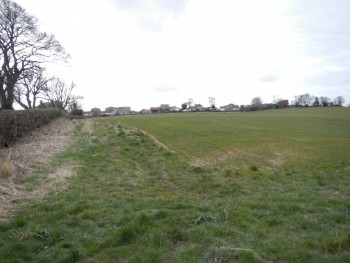- Navigation:
- Back to the Corpus index page
- RSS
Paxton Parish Church
Paxton, possible area of church location
- Dedication: unknown
- Diocese of St Andrews
- Deanery of Merse
- NT 93420 53071(?)
Summary description
Out of use by the mid-seventeenth century; no traces remain.
Historical outline
Dedication: unknown
A church and parish of Paxton appears only briefly in the historical record. It was confirmed between 1165 and 1171 as a possession of the canons of Holyrood Abbey by King William,(1) but there is no record of when it was granted to them or by whom it was given. The church or parish is recorded as an independent entity in no further surviving document and it seems that it was absorbed into the adjoining parish of Hutton, in which Holyrood had no interest.
Notes
1. Liber Cartarum Sancte Crucis (Bannatyne Club, 1840), no.27.
Summary of relevant documentation
Medieval
Synopsis of Cowan’s Parishes: Confirmed to Holyrood by William I, 1165x71, the church thereafter fails to appear in records and forms part of Hutton diocese.(1)
1165x71 Church of Paxstunis confirmed as a possession of the abbey of Holyrood by William I.(2)
Post-medieval
Books of assumption of thirds of benefices and Accounts of the collectors of thirds of benefices: No record.
1649 (6 Oct) Report in the presbytery records on the state of the church of Ormiston notes that the church stands in the middle of the parish with 550 communicants. The people of Paxton also go there. The kirk stands within the ‘lairds orchard’.(3)
Notes
1. NRS Presbytery of Dalkeith, Minutes, 1639-1652, CH2/424/3.
2. Cowan, I.B., 1967, The parishes of medieval Scotland, (Scottish Record Society), Edinburgh.
3. Liber Cartarum Sancte Crucis, 1840, ed. C. Innes, (Bannatyne Club), Edinburgh.
Architectural description
A parish here was confirmed to Holyrood by William the Lion at a date between 1165 and 1171, though the area it embraced was subsequently within the parish of Hutton.(1) The site of the medieval church is presently unknown. It had presumably passed out of any use by 1649, when it was reported to the Presbytery of Dalkeith that the people of Paxton went to Ormiston for worship.(2)
The site of the medieval church is uncertain; it may have been in the vicinity of NT 93 53, though no traces remain.
The existing church for the parish was built as Mordington and Paxton United Free Church, probably to the designs of the younger William Gray of Berwick, and was opened in 1908.(3) It is set out to a compressed T-plan with a vestry at the head creating an overall cross plan. The entrance front, at the base of the T, is of pink snecked rubble with ashlar dressings and it has an axial porch flanked by lancets; a two-light window with geometric tracery stretches up into the gable above the porch, and the gable is surmounted by a bellcote. The roof has arched braces of laminated timber which cross at the junction of the internal spaces.
Notes
1. Ian B. Cowan, The Parishes of Medieval Scotland, (Scottish Record Society), 1967, p. 162.
2. National Records of Scotland, Presbytery of Dalkeith, Minutes, 1639-1652, CH2/424/3, fol. 371.
3. The following brief account is based on that in Kitty Cruft, John Dunbar and Richard Fawcett, The Buildings of Scotland, Borders, New Haven and London, 2006, p. 606.
Map
Images
Click on any thumbnail to open the image gallery and slideshow.




